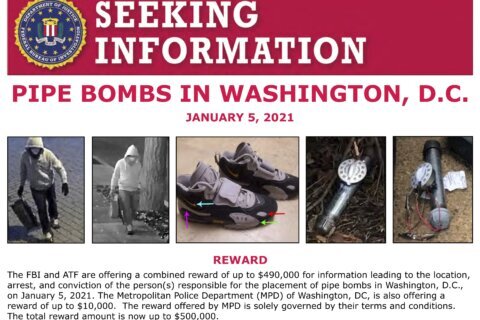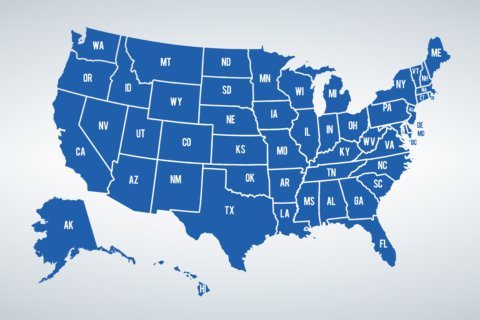Excerpts from recent editorials in the United States and abroad:
___
Oct. 26
The Washington Post on EPA rule requiring lead pipes gone within a decade
It is almost impossible to be against a rule announced by the Environmental Protection Agency this month requiring utilities to replace all lead pipes within a decade. After all, who opposes the swift removal of a deadly toxin from drinking water? But there’s a tricky road ahead, and it’s an expensive one to travel.
The 9 million or so service lines across the United States pumping poison through our homes and into our bodies cause all manner of maladies, such as high blood pressure, kidney malfunction, cognitive disability and hyperactivity. The EPA estimates that, in a country without lead pipes, 1,500 fewer people every year would die early of heart disease and about 900,000 fewer infants would suffer from low birth weight. The shift could even prevent 200,000 lost IQ points in children annually.
The nation has known for 40 years of these grave risks to public health. Now, finally, the EPA is not only mandating that drinking water systems everywhere locate and eliminate lead pipes within 10 years. It’s also lowering the acceptable level of contamination and tightening rules on testing — including, crucially, in child-care facilities and schools.
Tearing up the infrastructure that has undergirded much of urban America for nearly a century is vital. But it’s also difficult work. The woes afflicting Flint, Michigan, were far from unique. Other cities, such as Chicago, Baltimore and Syracuse, New York, have seen similar problems. Some, after public-relations disasters, have taken pains to improve their situations: D.C., happens to be a fine example; so are Newark and Denver. Others, however, haven’t acted as swiftly — and they might struggle to catch up.
Years of inaction shouldn’t be an excuse for lateness now. But the reality is that the federal government will have to play a substantial role for the country to meet its timeline. Smaller municipalities in particular lack the know-how and workforce to do this job on their own. They’ll require technical assistance, which, thankfully, the EPA already provides — and must furnish as proactively as possible.
Even unlimited help with the nuts and bolts of pipe replacement can’t solve the problem of cost. The EPA estimates that the tab for 100 percent lead pipe removal will come in somewhere between $28 billion and $47 billion. The federal government has chipped in substantially, with $15 billion in dedicated funding through the Bipartisan Infrastructure Law and just shy of $12 billion in drinking water revolving funds that states can use to replace lead service lines if they choose. The Biden administration pledged an additional $2.6 billion when it announced the new rule. Lawmakers should keep in mind that ridding the country of lead pipes will be a financial win in the end: The EPA initially indicated the health benefits would offset the cost of the bill more than twice over, but researchers at Harvard University’s public health school crunched the numbers and found that the benefit-cost ratio could be as high as 35 to 1.
Still, at the moment, the gap between what has been allocated and what’s needed is wide, and much of the difference will fall to the utilities — and probably, in the end, ratepayers. That’s particularly worrying, given that water systems don’t have to pay for replacing the portion of lead lines that are on private property (though they do have to take more aggressive action to replace them). The exception is understandable, considering the legal constraints on the EPA, but the neighborhoods struggling the most with contaminated water tend also to be the poorest. That means residents might be unable to afford to replace the pipes on their property.
The only good answer is for the water systems to do everything they can to replace low-income consumers’ lead pipes for free. But the government — federal, state and local — will probably need to chip in to persuade providers to perform gratis replacements. The District, for instance, has given D.C. Water funding to cover replacements on private property when the utility replaces the portion in nearby public space. This kind of collaboration is crucial: Utilities encounter enough trouble persuading residents to allow them to dig up their lawns even when it’s free.
This struggle stems, in large part, from a lack of trust. That shouldn’t come as a surprise: Lead pipes have been harming Americans for about a century now — installed sometimes by city mandate, then ignored and even dismissed as inconsequential while residents became sick and the science pointed plainly to their problems. Replacing the pipes is only part of the solution to lead poisoning: Many plumbing fixtures still contain contaminants; source water too often remains improperly treated. But it’s an essential step for governments at all levels to regain the faith of those they’re supposed to serve.
ONLINE: https://www.washingtonpost.com/opinions/2024/10/26/epa-lead-pipe-rule-replace-poisoning/
___
Oct. 25
The Wall Street Journal
’That didn’t stop me,” President Biden declared after the Supreme Court blocked his $430 billion student loan write-off in 2023. It sure didn’t. After striking out in court with three debt forgiveness schemes, the Administration on Friday unveiled another. Take that, judges.
The Education Department says its proposed rule would authorize forgiveness for some eight million borrowers experiencing “hardship.” Under the rule, the department can discharge debt if it calculates a borrower has an 80% likelihood of defaulting on payments within the subsequent two years based on 17 factors such as income, debt balances and assets.
The rule would effectively let the department forgive debt of any borrower any time it wants. The administration says high child-care costs could qualify as a hardship. How about high auto loan or credit-card payments? Did someone say moral hazard?
Borrowers are already allowed to postpone payments if they experience hardships, but the department says such forbearance isn’t enough. It also says that its latest plan “would reach borrowers” who “do not sufficiently benefit from other currently available forgiveness options”—and there are many such options.
They include the Administration’s SAVE plan, which caps monthly payments at 5% of income above $33,885 and cancels remaining debt after 10 to 20 years. An Eighth Circuit Court of Appeals panel in August blocked the SAVE plan, but the Administration has waived payments for millions of borrowers already enrolled for at least six more months.
In addition, the department’s public service loan forgiveness program cancels debt for nonprofits and government workers after 10 years. The Administration has eased terms so more borrowers would qualify and last week advertised that it has forgiven $74 billion in debt under the program—about $74,000 per borrower.
In April the department released a plan that cancels accrued interest for 25 million borrowers and forgives debt of those who entered repayment over 20 years ago or who “enrolled in low-financial-value programs”—meaning, forprofit colleges. The plan also promised to waive debt for borrowers with a “hardship.”
A federal court last month blocked that plan, but the department says its new rule “would operate separately and distinctly.” Courts are playing whack-a-mole with the Administration’s debt write-offs that end-run Congress, which never authorized such broad-based debt forgiveness.
Such lawlessness is one reason so many Americans discount the left’s assertions that Donald Trump endangers democracy. Mr. Biden acts like he’s king, and Democrats and media voices cheering him on have no standing to object if Mr. Trump follows the Biden precedent.
___
Oct. 23
The Los Angeles Times on the dangers of election denialism
Donald J. Trump is rightly being criticized for his threat that, if elected, he would deploy the National Guard and the military against “ the enemy from within,” a term he has applied to political opponents such as Rep. Adam B. Schiff and former House Speaker Nancy Pelosi.
Trump’s defenders argue that his threat concerned only what House Speaker Mike Johnson called “ marauding gangs of dangerous, violent people. ” And Trump, after much coaxing from a Wall Street Journal columnist to “clarify” his previous comments, told the newspaper’s editorial board that he wouldn’t use the military against his political opponents.
Yet there is a more immediate danger from another feature of rhetoric coming from Trump, his running mate Sen. JD Vance and top Republican supporters: election denialism. After seeming to acknowledge that he lost to Joe Biden “ by a whisker, ” Trump retreated to his old falsehoods about the 2020 election in his Sept. 10 debate with Vice President Kamala Harris.
The former president has since suggested that he would lose to Harris this year only if there is fraud. “They cheat,” he told a crowd at an Oct. 6 rally in Wisconsin. “That’s all they want to do is cheat. And when you see this, it’s the only way they’re going to win.”
The myth of election fraud seems to have stoked distrust of the electoral system among many Trump supporters. Polls suggest that many of them have concerns that the 2024 election will be marred by fraud. It also could serve as a manifesto for the most extreme MAGA supporters if Trump narrowly loses the election.
The riot at the U.S. Capitol on Jan. 6, 2021, is proof that lies can inspire Trump’s most unhinged supporters to engage in violence. Fortunately, the official counting of electoral votes has been designated a “ National Special Security Event,” and afforded the same level of security as presidential inaugurations and political conventions.
What about election day? Experts believe that violence at polling places on Nov. 5 is unlikely, and steps have been taken since 2021 to protect polling places and sites where votes are counted.
But sadly the possibility of election day violence can’t be discounted completely, given the level of threats and harassment aimed at election officials. Some school districts whose campuses are used as polling centers have gone so far as to cancel classes on Nov. 5.
The greater danger in the event of a close election might be violence or intimidation directed against election workers and state officials in the period between Nov. 6 and Jan. 6, 2025.
Suppose, as in 2020, early election returns reflecting in-person voting create a “ red mirage ” suggesting a Trump victory. But then mail-in ballots counted later alter the outcome in favor of the Democratic candidate. There would be nothing improper about such results, but Trump supporters primed to be suspicious of the system might assume that there was foul play — and overreact, perhaps violently.
That is why Trump’s self-interested disparagement of the election system has been so corrosive, absurd as some of his claims are. (He has asserted, for example, that he would win California “if we had an honest vote counter.”) On Monday, in response to a question at a news conference, Trump said he hadn’t seen evidence of cheating — though he ominously added: “Unfortunately, I know the other side, and they are not good.”
“The No. 1 variable that increases election violence is political leaders alleging election fraud,” said Rachel Kleinfeld, a senior fellow in the Democracy, Conflict and Governance Program of the Carnegie Endowment for International Peace.
Better late than never, Trump should stop sowing doubt about voting and put aside any thought of responding to a loss in a close election with spurious claims of fraud.
ONLINE: https://www.latimes.com/opinion/story/2024-10-24/editorial-roberson-death-penalty
___
Oct. 28
The Guardian
Israel’s rightwing government is recklessly steering the nation toward rogue-state status, with deeply troubling, escalating attacks on the United Nations that fuel a dangerous drift from international accountability. From its prime minister, Benjamin Netanyahu, down, it exhibits a brazen contempt for the global norms that govern human rights, conflict and diplomacy.
Hamas’s murderous attack last year in Israel, which left 1,200 people dead, ignited the current crisis. However, Israel’s response has been wildly disproportionate. Schools, hospitals and shelters have been struck, resulting in thousands of civilian deaths. In the year since the Gaza war began, the evidence supporting genocide claims against Israel has grown, with the UN human rights chief, Volker Türk, last week condemning Israel’s military for “effectively subjecting an entire population (in north Gaza) to bombing, siege and risk of starvation”. Israel has killed UN staff in Gaza and attacked UN bases in Lebanon. Israeli officials too often accuse the UN of antisemitism. The UN secretary general was barred from Israel for failing to “ fully condemn ” a missile strike by Iran on Israel this month.
By voting to cripple the operations of the United Nations Relief and Works Agency (Unrwa), Israel’s parliament has undermined essential services provided to Palestinian refugees, with no replacement. Israel alleges Unrwa allowed Hamas militants to infiltrate its staff, a charge that the UN denies. The move exposes Israel’s irresponsible international behaviour. Undermining the UN and its humanitarian agencies – which protect civilians and alleviate emergency conditions – is indefensible. These organisations are pillars of the international legal and governance system. Though imperfect, this system remains essential in preserving a semblance of order, if not justice, within global relations.
The US and its allies have shielded Israel from the consequences of its actions. Washington could end the war tomorrow by stopping its arms flows and forcing a ceasefire deal on both sides that would see Israeli hostages go home. It should do so forthwith. But American politics has been paralysed by the need to win an election in which criticism of Israeli actions is deemed beyond the pale.
The UN asserts, correctly, that the US’s double standards undermine international law enforcement. This hypocrisy creates competing justice standards, weighing crimes against humanity against a state’s strategic value. That variance can be seen in the recent Brics summit communique, which acknowledged the international court of justice’s provisional measures against Israel, aimed at preventing genocide and Geneva convention violations. The US and allies like Britain cannot ignore Israel’s breaches of international law; complicity in war crimes would reflect a disregard for civilian lives. Yet Israeli soldiers rarely face accountability.
Last month’s UN general assembly resolution reflects a global consensus that peace depends on dismantling illegal settlements and Israeli military withdrawal. Brokering peace between Israel and the Palestinians through international mediation hinges on the UN’s ability to enforce its resolutions.
The UN security council’s dysfunction, with major powers using the Middle East for political gain, indicates that without a new approach, meaningful progress on peace in the region is unlikely. The US must restrain Israel to initiate a viable international peace process; without this, any foundation for peace crumbles.
___
Oct. 25
The Dallas Morning News on U.S.-Mexico cooperation fighting cartels and building Mexican institutions
From 2006 to 2012 during Felipe Calderón’s presidency, Genaro García Luna was Mexico’s top law enforcement official, in charge of building a strategy to confront the powerful drug cartels and sharing intelligence with U.S. officials. He was also on the payroll of the Sinaloa cartel.
Earlier this month, García Luna — who was arrested in Dallas in 2019 – was sentenced to 38 years in prison by a federal judge in Brooklyn, a dramatic downfall for a man who once led Mexico’s federal police force and, according to testimony, received millions of dollars in bribes and served as the de facto protector of the cartel.
García Luna, 56, is the highest-ranking Mexican official ever convicted of corruption, and his harsh sentencing sends a message to other public officials, as the judge overseeing the trial said. At the very least, corrupt officials from Mexico and elsewhere will avoid setting foot on U.S. soil. But most importantly it shows that the U.S. still has strong accountability tools.
These tools also include the work of the Drug Enforcement Administration, the FBI and Homeland Security Investigations, which were instrumental in the arrest last August of Ismael Zambada, leader of the Sinaloa cartel. That blindsided Mexican officials, who were not informed of the operation leading to the drug lord’s arrest.
It is unlikely that the U.S. officials will fully regain trust with their Mexican counterparts, but the timing of the García Luna sentencing offers an opportunity to reengage in bilateral cooperation to fight drug traffickers and corruption. That was severely damaged in the last few years under the Andrés Manuel López Obrador administration.
There is a new Mexican president, Claudia Sheinbaum, and soon there will be a new U.S. administration. Better cooperation can lead to better results in the fentanyl war, while improving public safety and strengthening institutions in Mexico.
We are not naive about the prospects. Sheinbaum likely will continue López Obrador’s policy of non-confrontation with the cartels, and she is now leading a country in which her predecessor allowed the Mexican armed forces to gain more strength, power and influence.
This is not something to take lightly, and the case of Gen. Salvador Cienfuegos looms large. The Mexican general was arrested by U.S. officials in 2020 and accused of protecting drug lords, but charges were dropped after political and diplomatic pressure. The U.S. capitulated after López Obrador threatened to expel the DEA.
Since then, the power of the Mexican military has grown and now it oversees major infrastructure projects, tourism development, management of ports and even public health, often under unwritten agreements and with little oversight, opening the door for corruption.
The U.S. should remain vigilant even as reestablishing drug enforcement cooperation must be a priority for the next administration. The García Luna sentencing and other recent sentences against former Latin American public officials are sending the right message: There is zero tolerance for corrupt officials.
Copyright © 2025 The Associated Press. All rights reserved. This material may not be published, broadcast, written or redistributed.







